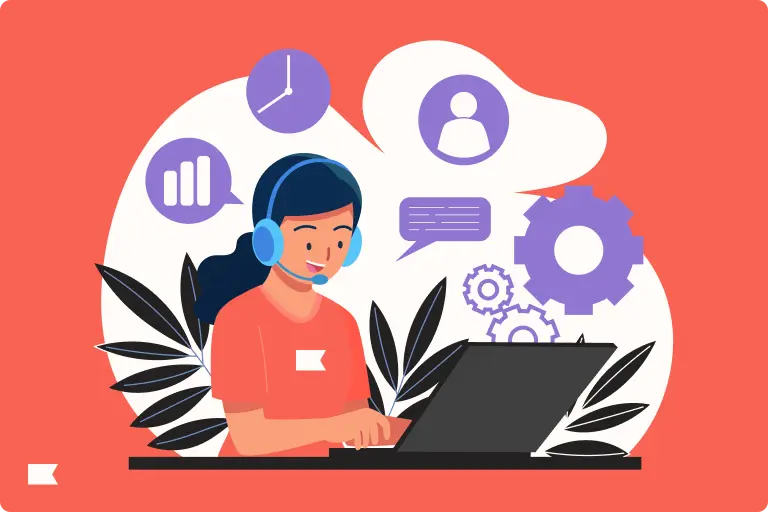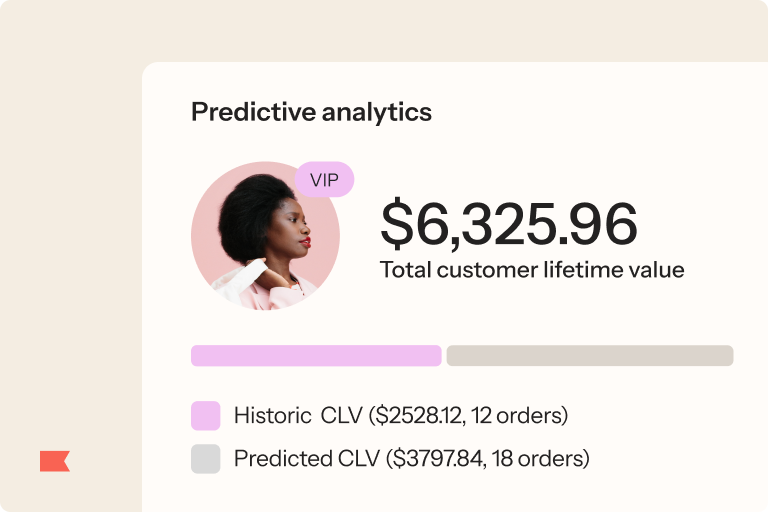What a seamless customer experience looks like for B2C brands

An excellent customer experience used to mean prompt customer service, friendly interactions, and high-quality products and services.
Now, great customer experiences are more complex. According to Klaviyo’s 2025 online shopping report, 77% of omnichannel consumers use 3–4 channels when shopping. That means brands have more work to do in meeting customers where they are.
Customers shop across online and in-person channels, seek out customer support while they browse, and expect brands to know their preferences. They’re also using AI to shop. Klaviyo’s 2025 AI consumer shopping survey found that 60% of consumers have used AI shopping assistants in the past 3 months.
Today, a “seamless customer experience” means:
- Knowing a customer’s buying intent, preferences, and historical behavior
- Delivering consistent, personalized interactions across multiple channels
- Removing friction from the buying process with always-on service
Here’s what effortless experiences feel like to customers, and how you can implement them to meet rising expectations.
1. Connected brand experiences across the entire customer journey
Klaviyo’s future of consumer marketing report found that the No. 1 frustration consumers have when shopping across channels is inconsistent pricing and promotions. This can happen when your data is siloed across multiple software platforms that aren’t integrated.
Seamless customer experiences anticipate someone’s next actions and fill in the blanks for them. For example, rather than customers having to use one account to manage a subscription and another to access loyalty points, an integrated customer experience ensures they can do both from the same account—without ever leaving your online store.
Connected experiences supported by integrated customer data platforms may look like:
- Instant loyalty points redemption available at check-out
- Pre-filled customer information at check-out
- Consistent prices and product information across in-store, online, and mobile touchpoints
- Subscription renewal text reminders that are tied to customer accounts
B2C brands win when the customer experience feels connected, fluid, and personalized. Here’s how to set up your marketing and service teams for connected experiences:
- Start with a unified customer data foundation. Use a CRM with a built-in CDP and a robust integrations ecosystem to bring together data from email marketing, text message marketing, customer service, in-store purchases, loyalty programs, subscriptions, gift cards, your ecommerce store, and more.
- Offer a one-stop customer hub. Set up a self-serve customer portal that centralizes wishlists, personalized suggestions, order information, loyalty programs, and customer support in one place.
- Continue to gather data for customer profiles. As you interact with customers across various touchpoints, that data should automatically feed into customer profiles that house all the information you need to serve customers with personalized support and marketing messages.
Skincare brand Naturium, for example, integrated their loyalty program with their ecommerce store and CRM. Under their new program, Consistency Club, customers can create an account, earn and redeem points when they shop, add a subscription, and more.
Now, the team at Naturium can welcome new Consistency Club members with automated flows to let members know when they’re about to unlock a new tier or have points to redeem.
It’s a win-win for both the brand and the customer: the customer is more aware of the points they can redeem, and the brand generates more revenue through their loyalty program. Since connecting their CRM and loyalty program, the team feels they have a competitive advantage in a crowded space.
2. Integrated online and in-store shopping experiences
Many customers choose to shop with the same brand both online and in-person. But customers shouldn’t feel these experiences as separate.
If shoppers are walking by your physical store and want to buy an item they saw online, they should be able to. If they’re in-store and want to read product details and reviews on their phones, they should be able to do that, too.
Bridging your online and in-store shopping experiences should be a customer data-first, tech-enabled endeavor. Here’s how to connect the online and in-store customer experience:
- Send store-specific offers based on location and behavioral data. Use customer location and behavioral data to send relevant in-store promotions to high spenders or frequent purchasers. For example, apparel and home brand Jenni Kayne uses email to encourage in-person shopping, strategically sending online shoppers discount codes redeemable only in stores. And if a customer near a store abandons a $5,000+ cart, their local store manager gets a notification to send 1:1 outreach.
- Implement buy online/pick up in-store options. Create smooth internal processes and automations, like alerting customers via text when their orders are ready and providing staff with customer context and order information for personalized handoffs. Or, set up an automated message that notifies store managers when items haven’t been picked up for more than a few days.
- Use mobile technology to improve in-store shopping. Make it easy for customers to browse product details while shopping in-store. Allow customers to scan QR codes to read product reviews, check online availability, see FAQs, and more.
Family-owned ice cream brand McConnell’s Fine Ice Creams connected their ecommerce platform to their delivery platform, point-of-sale (POS) software, and CRM, so they can target customers based on location with online offers. They use zip code segmentation to send messages to local customers, prompting them to order for delivery directly through them.
McConnell’s has also launched two automations for in-person customers triggered by POS data. First-time customers get a thank-you message that introduces them to the brand, and 7–10 days post-purchase, every in-person visitor gets invited to return to the store or order delivery. McConnell’s Square POS revenue from Klaviyo flows jumped 8x YoY.
3. Contextual marketing and service that match real-time customer needs
Customer journeys are non-linear and, along the journey, customers are bound to have questions. When looking for ways to improve your relationships with customers, think about the connection between marketing and service—and how each team can help the other.
Klaviyo’s state of B2C marketing report found that 75% of marketers say that customer service makes up more than 10% of their role. Customers often reach out on marketing channels looking for help, so aligning these two teams can have a big impact on customer satisfaction.
The same research showed that brands with aligned marketing and customer service teams are 14% more likely to have customer satisfaction scores (CSAT) that are higher than 70%.
To provide cohesive, contextual marketing and service for customers, integrate your marketing and service platforms. This will set you up to respond to customers’ real-time needs by:
- Equipping your human and AI customer agents to answer common questions with full order history, on-site behavioral data, conversational context across channels, and more.
- Turning support conversations into re-engagement opportunities, such as following up after a negative experience with a free gift.
- Pausing marketing messages when a customer has an open support ticket attached to their profile.
- Using an AI customer agent to address common objections or suggest complementary products when a customer is about to abandon a cart.
- Offering self-service options within a self-service customer hub that empowers shoppers to manage their own orders, interact with AI customer agents for quick answers, and save items to a wishlist.
Thirdlove’s self-service customer hub, for example, gives shoppers access to a personalized “For You” page that’s always updating based on browsing activity. Shoppers can view and favorite items, receive personalized product recommendations, and redeem loyalty points. Within 30 days, the intimates brand’s loyalty point redemption rate hit an all-time high of 30%.
Improve customer experiences with unified marketing and service
With Klaviyo B2C CRM, you can gather marketing, service, and customer data into a single platform—and ultimately deliver 1:1 personalization at scale.
Over 157,000 consumer brands trust Klaviyo as their data and marketing platform. Create the ultimate customer experience with the complete Klaviyo Service suite, which includes:
- Customer Hub: a personalized account where customers can manage orders, redeem offers, discover products, and get support—all in one place
- K:AI Customer Agent: a 24/7 AI assistant that’s trained on your storefront and customer data to answer questions, recommend products, and resolve issues instantly, across web chat, email, text messaging, and WhatsApp*
- Klaviyo Helpdesk: a unified workspace for AI and human agents to deliver service across email, chat, SMS, and social, providing full customer context for faster response times and more personalized interactions**
*Customer Agent is currently available in English. Additional languages will be available in 2026.
**Helpdesk supports two-way conversations in any language, as long as both the customer and agent use the same language. Klaviyo does not translate messages between languages. The Helpdesk interface will appear in the language you’ve selected in your Klaviyo account settings.

Related content

See how Customer Hub, Customer Agent, and Helpdesk powered faster support, reduced tickets, and boosted revenue during Klaviyo Service’s first BFCM.

Post-purchase experiences are where customer loyalty begins. Learn how to automate and personalize them to grow your B2C brand

Discover how lifecycle marketing transforms your CRM into a growth engine, driving retention, automation, and personalized B2C customer experiences.